50 Visual Content Marketing Statistics: The Complete Guide

Table of Contents
- What is Visual Content Marketing?
- 50 Visual Content Marketing Statistics You Should Know in 2022
- Key Takeaways
- Conclusion
- FAQs
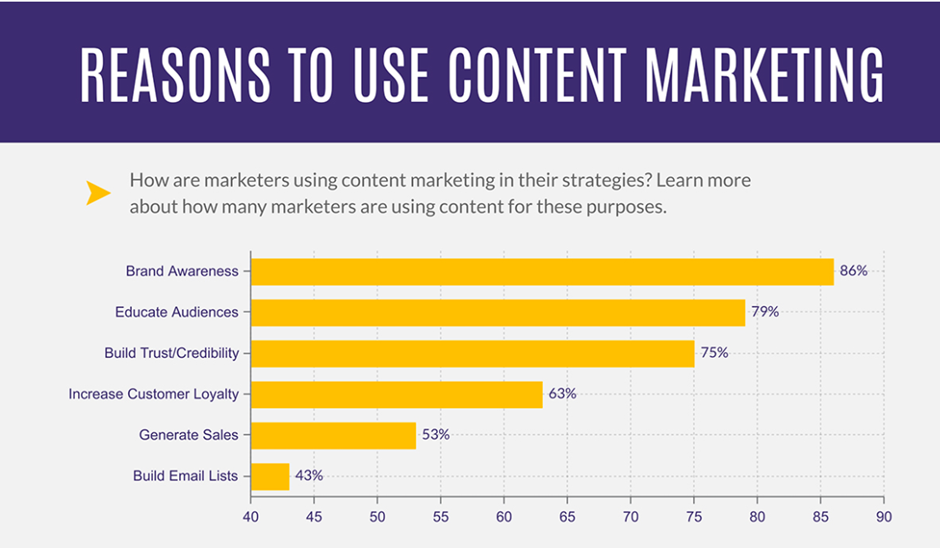
Visual content is critical for user participation, brand relevance, and commercial success. 88% of marketers said they used visual content in 50% or more of their content. Visual content marketing is becoming increasingly vital as we move into the digital era. In light of this, we’ve compiled a list of more than 50 visual marketing statistics you should be aware of in 2022.
What’s the point of learning about them? Your marketing components will be more effective and profitable if they have high-quality graphic content that engages your audience. The visual appeal of infographics, photos, and videos and their readability and comprehension are two of the many benefits of using graphic material.

What is Visual Content Marketing?
Using pictures to deliver critical information in a visually appealing manner is referred to as “visual content marketing.” With visual content, you want to draw visitors into your website, social media accounts, and other platforms to see what you have to offer. Information graphics, infographics, and “signature branded visuals” are all types of visual content marketing that promote textual, audio, or video material. Here are 50 visual content marketing statistics for effective marketing.
50 Visual Content Marketing Statistics You Should Know in 2022
There are several numbers to consider when it comes to visual content marketing. What works, doesn’t work, and everything in between.
1. Visual content is remarkably engaging
Visual material piques viewers’ curiosity and entices them to interact more. For 42% of marketers, stock photography is the most commonly utilized visual material. Similarly, by 2022, the video will account for 80% of all internet traffic.
To put it simply, visual content creates more traffic, likes, following, consumers, visit-time, and money than text. People are glued to it as visuals are incomparably more enjoyable to look at than a large block of text.
The following statistic may help shed light on the matter.
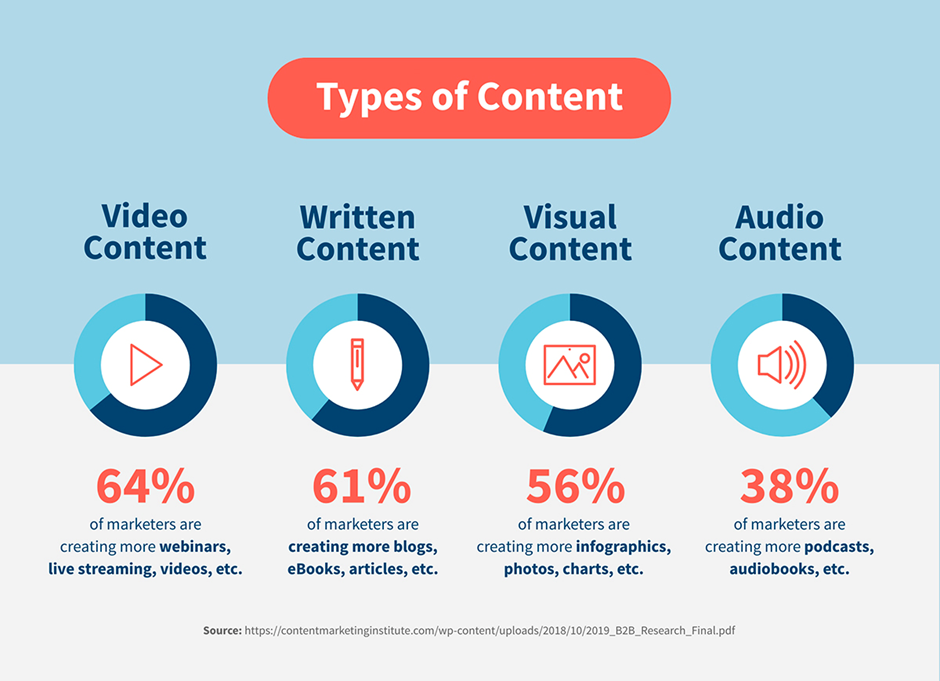
2. The first impression is everything
Visual information makes up 90% of the data sent to your brain. So it’s no wonder that visual content has such a substantial impact on the way people interact with it. Because of this, your brain has developed to assess new information quickly.
In this scenario, you need to establish a solid initial impression of your material. Keep in mind that you have a few seconds to pique the reader’s interest.
The figure also serves as evidence of the merits of keeping things simple. You’re a winner if your infographics or visuals quickly deliver value to the audience.
3. Visible content is memorable
Another advantage of visual material is that it is easily recalled. It lingers longer in the minds of spectators. This is a must-have for all marketing-related content, even if you’re writing educational material.
People will remember your business or the deal you promoted in a post longer if you use visual material. It increases the likelihood of people returning and recognizing the value that you offered to them in the future on your site or social media account.
In the end, people will spread the word about how great your product or service is if they remember who you are.
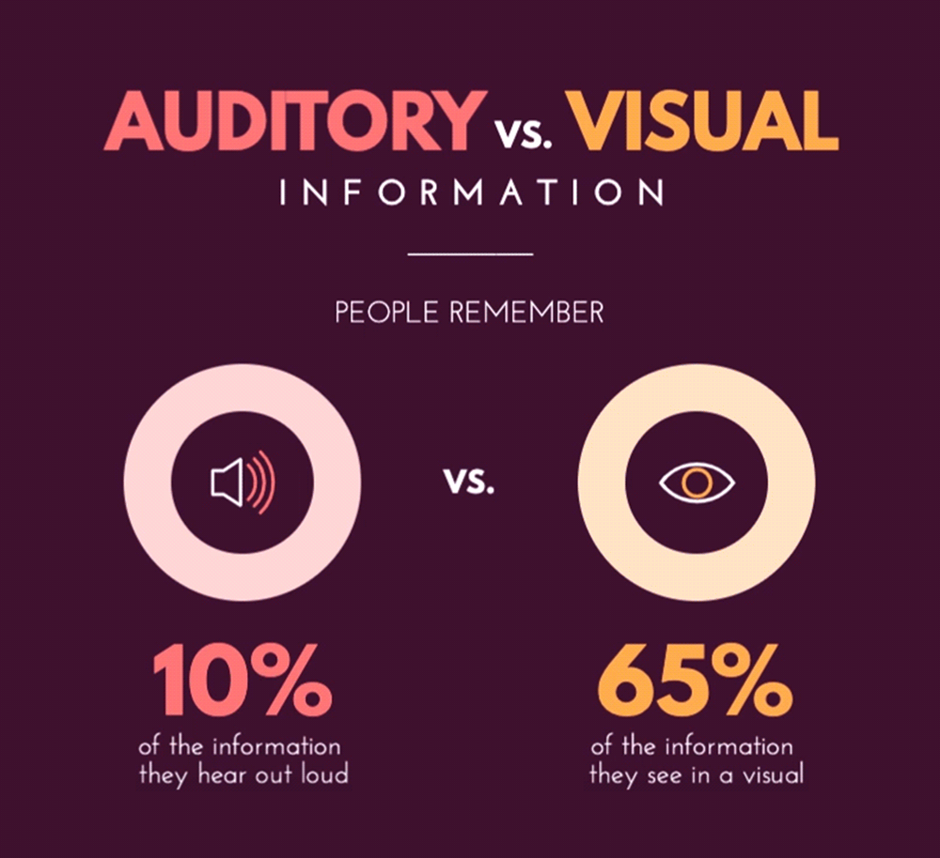
4. Color is a crucial factor
To pique the audience’s interest, college professors always instruct students to “use vivid colors.” The same principle applies to all forms of visual marketing. Color may catch the viewer’s eye and help them remember your brand and the message you’re trying to get across in the future (so definitely keep your colors consistent).
According to a research study titled Impact of Color on Marketing, color has been shown to have various psychological impacts, including the ability to influence food, mood, and even sleep.
As a result, it is not a surprise that color significantly impacts visual marketing.

5. Tell your brand’s story
Advertising is all about storytelling, and understanding how to create tales with your visual material is essential to building your brand.
Every visual material has a brand story, and video advertising is no exception. You build an emotional connection between the customer, your brand’s beliefs, and, eventually, your products by delivering storylines and integrally attaching them to your brand.
Use stories in your interactions with others since they are the foundation of all human communication. Look at Nike’s television advertisements, and you’ll find that it works. Every visual content marketing stat will show you that.
6. Every story requires a hero
Go Compare’s usage of Gio Compario as a central character in their visual content strategy shows that this tactic is still effective.
The main character is an absolute need in any novel. Add a character to your ads, and you’ll be able to convey a great deal of information to viewers about your company and its products.
Your brand values are communicated through characters, entice viewers, increase brand awareness and drive sales.
7. Resolve the issues of your customers
One of the essential marketing rules is to address your customer’s issues whenever you generate visual content.
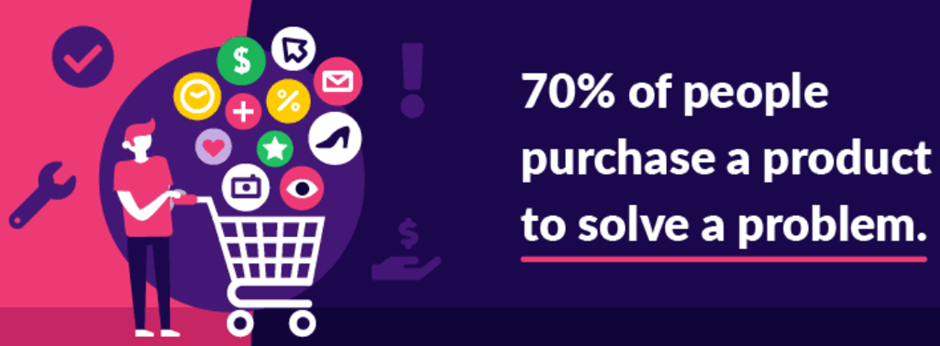
Long-term success is inevitable if you fix challenges through content strategy, infographics, or visual marketing materials. Show individuals how your product or service will improve their lives rather than merely tell them about it.
8. Priorities for the content post-covid
The COVID-19 epidemic has prompted marketers to re-evaluate their strategies. In a CIM poll, restoring a brand’s reputation was critical.
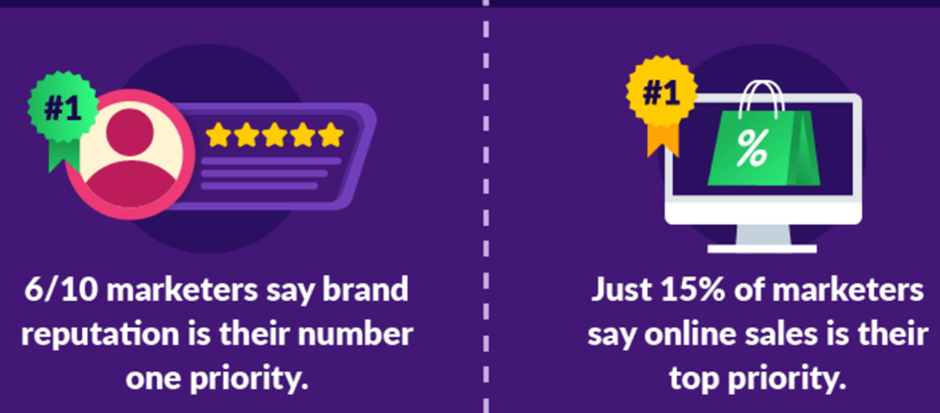
Lockdown has put several industries out of commission. It is expected that after a period of little or no business, marketers believe it is critical to improving the image and familiarity of the brand they represent.
Boosting the brand’s reputation will increase revenue in the long run. When planning your visual material, you should keep this in mind. What’s the greatest strategy to raise your company’s profile?
9. The biggest obstacles faced by marketers
Making content that people want to read and share is difficult. The generation of visual content is the most significant issue for 36.7% of marketers. What makes it so difficult? You must consider many factors to create an outstanding piece of visual content for your marketing plan.
Visual content marketers struggle with design, research, and data structure. The most challenging element of the job is ensuring that your visual material is regularly delivered.
10. Marketers must produce high-quality content
Don’t do it, just in case you’re wondering. Approximately 11% of respondents to Venngage’s survey stated they spend more than 20 hours a week producing visual content. In my opinion, their outcomes were much better.
This is because visual material is so crucial to your brand. You might damage your brand’s reputation if you don’t get your content correctly. Poor public relations are akin to ineffective marketing strategies. Some of you may remember Taco Bell’s Chihuahua commercials from 2000 when they first showed them. Due to the ads’ lack of relevance, sales fell by six percent due to their appearance.
11. Don’t compromise on spending
Spending a lot of money on visual material does not guarantee more outstanding outcomes. Any usage of graphic content will provide that. However, you should spend more money on visuals.
That’s because the most compelling visual material isn’t cheap. Videos may cost anything from $1200 to $50,000 to make and are often recognized as one of the top content kinds.
While many firms cannot afford to produce video regularly, those that do are rewarded (and their spending).
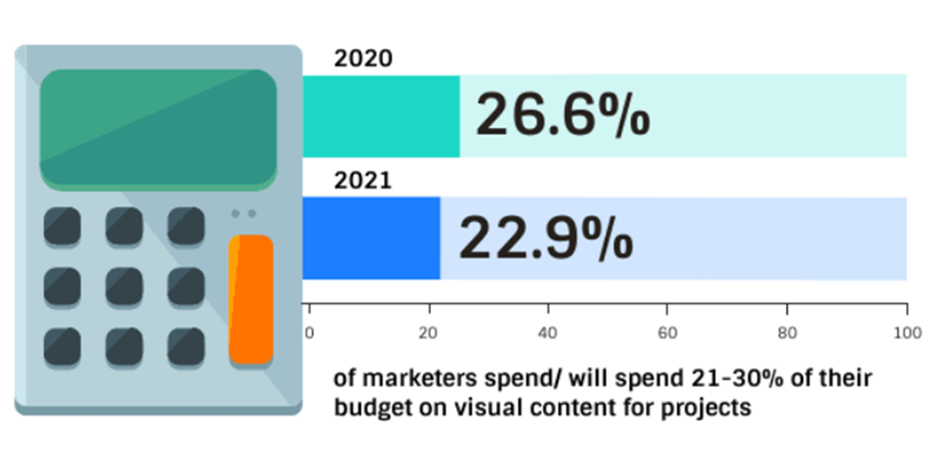
Marketers spend money on the following:
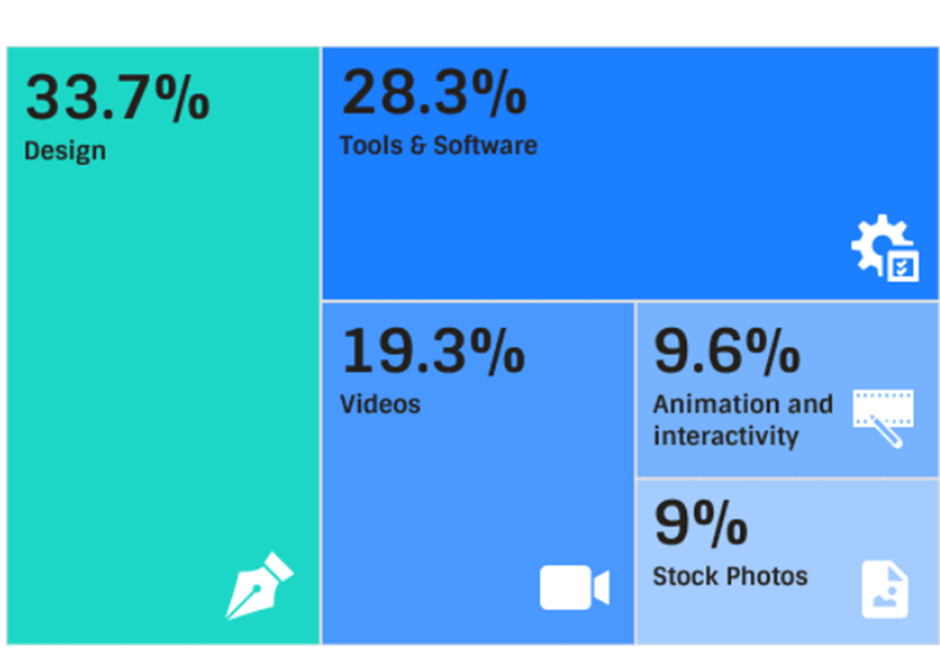
12. How is visual content made?
Online tools are the most preferred method of producing graphic content for many marketers. Marketers utilize standard graphic design tools more than professional design software due to their quality and usability.
It’s best to go with in-house designers if you want your visual material to be consistent and high-quality.
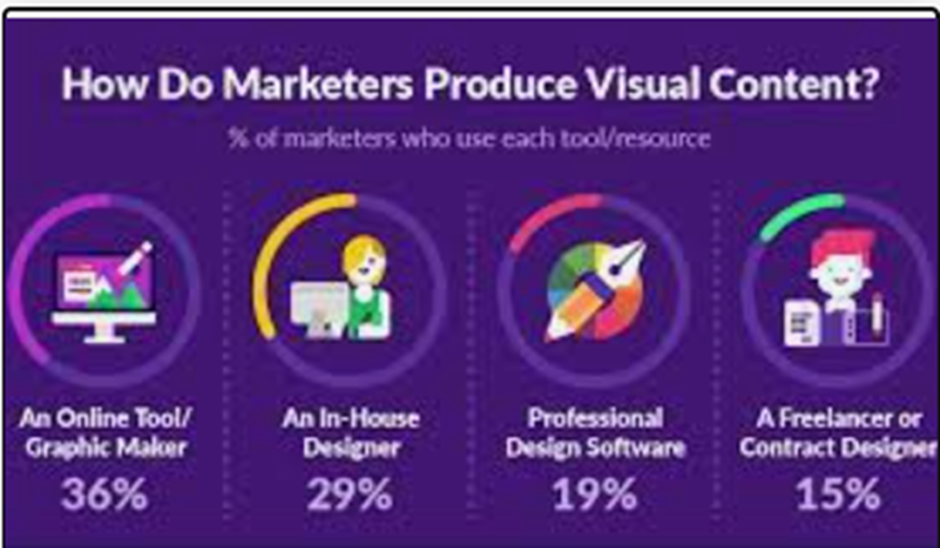
13. The visual content is critical
It’s like a big deal. That’s why, according to Venngage’s survey, visual material is essential to everyone who took part. Marketers can’t envision doing business without visual content. As a result, if you don’t use graphic material regularly, you’re the only one who isn’t.

14. Digital visuals are on the rise
The following is a clue if you need any more persuaded about the direction things are going:
The internet is a powerful medium that is constantly evolving. Ads, viral videos, photos, and graphics have inundated the internet during the past decade and a half.
Print is a thing of the past. As a result, the internet is thriving. According to the present growth, there is no sign that this will alter soon. The popularity of visual material on the internet will only grow in the future.
Different types of visual content
There are a plethora of graphic assets at your disposal. These are some of the most important content categories, as measured by the following metrics.
15. Marketers’ use of visual content
Visuals are vital to 64% of marketers. Only 9.6 percent of content marketers don’t need images for their campaigns (Venngage). Marketers often use stock pictures, which may come as a shock to some. Venngage’s annual poll found that 40% of respondents said they use them more frequently than any other sort of visual material.
That’s probably because they’re so easy to find and connect to a blog article or social media post.
Even so, that doesn’t always imply that they provide superior outcomes. The following data suggests that putting in a little more effort might significantly impact your marketing objectives.
16. Graphics make the biggest impact
When asked, 40 percent of the 200 marketers who took part in Venngage’s poll indicated that their marketing success was due to the use of creative visuals.
Infographics, unique advertising visuals, and drawings all fall under this category. Despite being the most often utilized visual material, just 13% of respondents said stock photographs were the most effective.
You can’t cut corners on quality, as seen by the outcome. Going the extra mile can have a significant influence on one’s life.
17. The amount of video content is enormous
As the popularity of video material on the internet grows, it’s no wonder that sales are surging. According to estimates, consumer internet traffic will be 82% video by 2022. 15 times as much footage was uploaded in 2018 as last year.
As a result, video marketing will become increasingly significant in the future. In 2021 and beyond, it will undoubtedly be the most popular form of media.
So, why is video so popular?
18. Video helps solve issues
Video is unlike any other kind of media in its ability to stimulate, engage, intrigue, and convert. Because of its structure, video is the most exemplary medium for addressing consumers’ issues because it can convey far more information than any other medium.
Despite its popularity, video remains the most challenging visual content for many marketers to produce and integrate into their campaigns.
However, if you’re successful, the rewards might be enormous.
19. Video helps increase sales
Businesses can benefit from video, too, based on the value it provides customers.
In general, customers will buy your goods if you address their problems. That’s why 64% of individuals who view a sponsored social video end up making a purchase.
As a result, you should carefully consider increasing the amount of video material you have on your website. It’s the most lucrative method of visual content marketing in terms of ROI.
20. Infographics assist in the learning process
Who’d have thought it? Using infographics is an excellent method to back up your statements in an article or presentation, while some firms do not include any supporting text at all.
This is because infographics are so effective. These visuals captivate and maintain the viewer’s attention while teaching them something challenging to read or concentrate on.
In other words, the appropriate combination of pictures and text conveys the idea perfectly and may make even the banalest issues understandable to the general public. That’s why 84% of those who took part in an Infographic World poll said infographics were successful.
21. The importance of photography
Storytelling is a crucial component of effective marketing, and coming up with something unique is a sure way to do just that.
If you’re looking for results and a distinct brand image, you should avoid using stock pictures because they’re quick and easy. The best line of action for you is to take your images. Brands may communicate their narrative through photography, capturing anything from branded events to product advertisements. Photographs allow you to demonstrate to clients how your service benefits them personally. Your visual material may have a significant impact if you address a customer’s problem!
22. The rise of live streaming
In the year 2021, live streaming will be massive. Twitch is an excellent example of this since its daily audience has grown tremendously over the past few years. Compared to 2019, Twitch witnessed a 14.3% growth in 2020.
It’s time for you to start giving a thought about how you might include live-streamed material into your visual content strategy.
Facebook Live and Instagram Live are two of the most popular platforms to broadcast live. The answer is yes. Compared to regular video, Facebook Live has a 10x higher level of engagement, yet the video is already quite engaging.
23. ‘Reusable’ interactive content
Interacting with your marketing materials can be a fun experience for visitors when you use interactive content. Interactive visual material includes interactive films, games, interactive charts & maps, widgets, and even quizzes.
Unlike static images or graphics, interactive material is more intriguing and attracts more attention than static content. As a result, engaging customers with interactive content is an excellent strategy for increasing sales. It not only piques people’s attention, but it also entices them to keep returning.
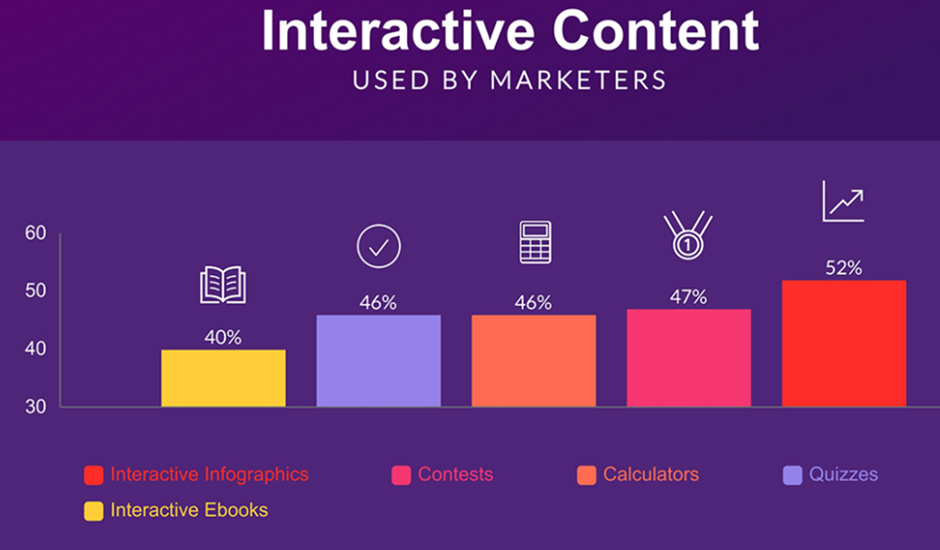
24. Memes, GIFs, and Emojis boost clicks
GIFs and emojis are examples of similar modes of communication that provide similar effects. According to a GetResponse study, emojis boost email open rates by 9 percent. Emojis. While adding a cinemagraph (a form of GIF) in an ad for Mist Twst raised CTR by a stunning 75%.
The use of GIFs, memes, and emojis in marketing to teenagers is on the rise, and there are many examples to prove it. Domino’s has made it possible for consumers to place orders using the pizza emoji for the first time.
Even though memes, GIFs, and emoticons have proven effective, few marketers regularly employ them. According to a Venngage report, just 4% of marketers utilize memes and GIFs as their most often used visual material.
25. The visual data industry expands
As a result, the market for data visualizations like graphs and charts is rising. Data visualization is expected to develop at a CAGR of 9.69 percent between 2020 and 2026. From $2.99bn to $5.17bn, that’s a rise in value.
More small and medium-sized firms are increasingly utilizing data visualization to help with their marketing, training, and decision-making. Big data and multi-device access to data visualization are two further aspects driving development.
In addition to helping organizations make better decisions, one can also use data visualization to convey a story or make a point that one cannot dispute. That’s why it’s so effective in content marketing, especially for B2B companies.
26. Most effective visual marketing methods
Let’s look at some marketing channel data (i.e., the places where marketers distribute visual content). There are several different platforms that marketers use.
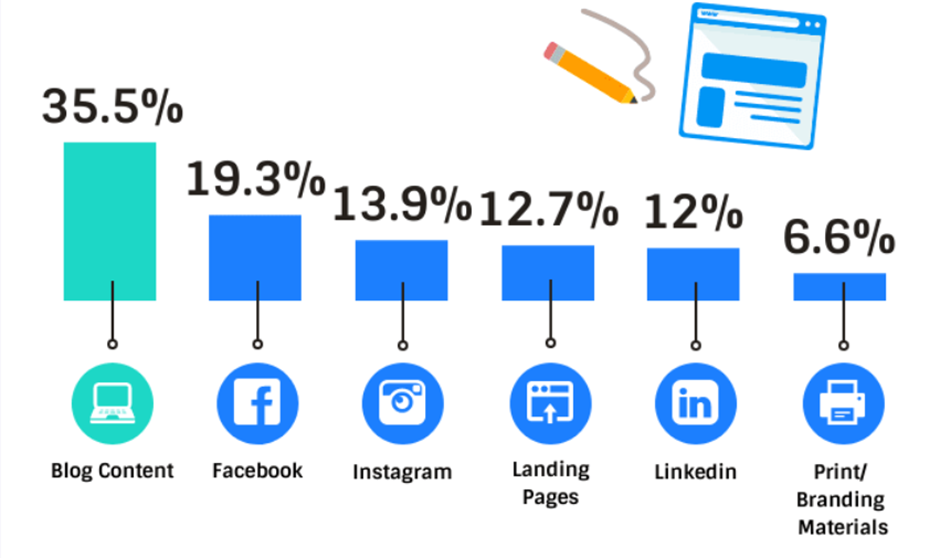
Visual content is most commonly used for blogs and website landing pages, followed by Instagram and Facebook. When it comes to visual content marketing in the past, print and branding were the go-to options. However, because of the boom on the internet and the rapid fall of all offline channels, marketers are currently developing more material for particular social networking sites than for print.
27. Digital billboards are still effective
In time, traditional billboards may succumb to the effects of the sun’s harsh rays. Even yet, digital billboards still have an essential function to play in visual content marketing, even if the notion as a whole has been abandoned.
When it comes to advertising, billboards are an excellent method for reaching specific groups of people, such as travelers and individuals in a particular route. People may be on the go, but digital billboards continue to encourage high levels of interaction. Digital billboard advertisements “stand out” more than internet ads, according to a study conducted by Neilsen.
People not only look, but they also remember. Even if a potential customer has to pass past your billboard several times a day, if it’s the right product, you’ll get their attention.
28. The decline of traditional print media
In the last year, people worldwide viewed 12.2 billion minutes of video on the internet. The COVID-19 epidemic has expedited the collapse of print and (as a result) print advertising. People have been stating this for a few years now. For now, it’s not a brilliant idea to put graphic material in publications like newspapers or magazines. Print sales are declining, and more people turn to the internet to get their information.
According to 72% of marketers, branded content is more effective than magazine adverts. Considering how much of this information is made up of videos, it’s no wonder that marketers are advertising online.
29. Email branding consistency is critical
Maintain consistency in your branding. When sending out marketing emails, employees will better understand what graphics, headers, and logos to utilize because of the implementation of branding rules.
Put your logo at the top of every email because that’s what consumers notice first! From there, you may establish the brand’s consistency throughout the rest of the company. MailChimp, for example, is a fantastic tool that may assist you in this endeavor.
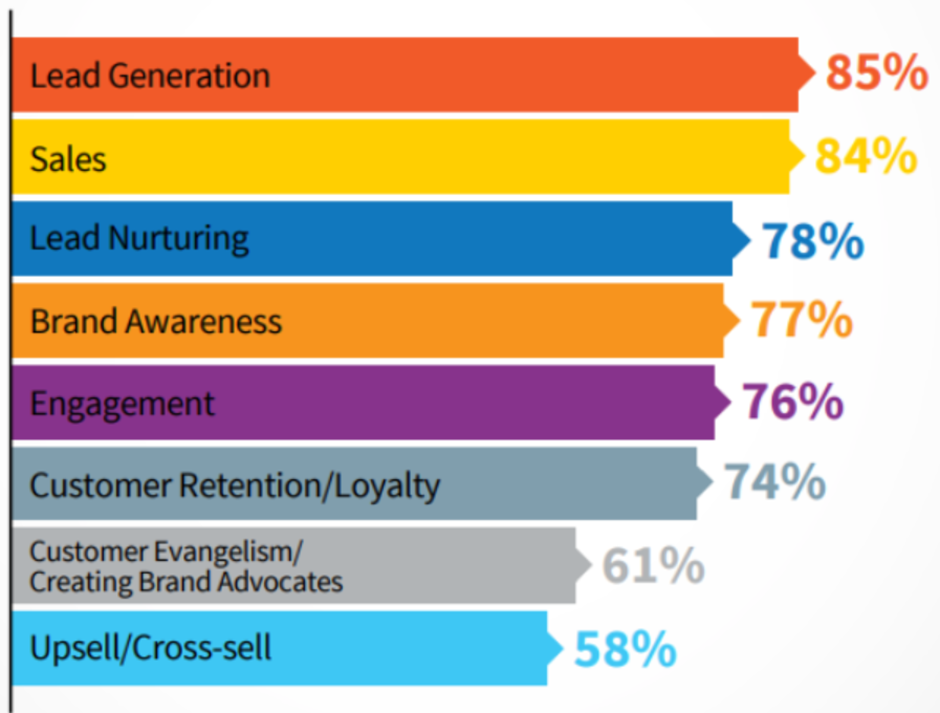
30. Email with video is fantastic
Adding video material to an email is also a fantastic idea. We’ve previously established that fixing the viewers’ issues is a critical component of a video’s ability to stimulate and interest them. What better method to demonstrate your goods or service to a consumer than with a video you’ve emailed them?
In any case, customers are likely to look up a product video online before deciding to purchase it. With minimum work, you’ll see a significant rise in click-through rates, which will lead to a massive increase in conversions.
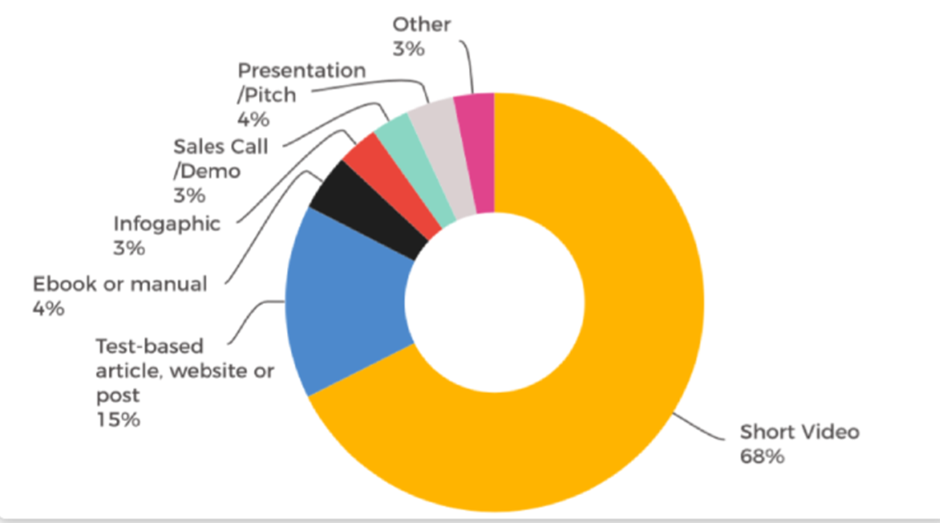
31. Where do people watch the most videos?
Some of these sites are beautiful places to start if you use video to target individuals.
The two most popular sites where people go mainly to view videos are YouTube and Facebook. Every day, YouTube users watch one billion hours of video.
Your material will acquire the most views and interaction if you post it on video sites like YouTube and Vimeo. Videos on YouTube are attracting more viewers!
A YouTube video might be posted first and then embedded into your email message. You’ll be able to accomplish two extraordinary things at once this way.
32. Include visuals in your blog
81% of companies choose to promote videos on Facebook. (SocialMediaToday)
Infographics, for example, are critical for your blog’s visual appeal. As part of a poll conducted by Orbit Media, respondents were asked how they included many photographs in their postings and how effective they were. Many bloggers utilize more than one image in their posts, and they get positive effects.
In contrast, just 16% of responders were successful with only one image. The link between success and the number of photographs you utilize is astounding. Because of this, most bloggers now include pictures and other forms of visual media in their posts.
33. Visual social media platforms are popular among teens
Instagram is used by 72% of teens, while Snapchat is used by 69% of the same age group. Since 2015, both have risen by more than 20%. (Pew Research)
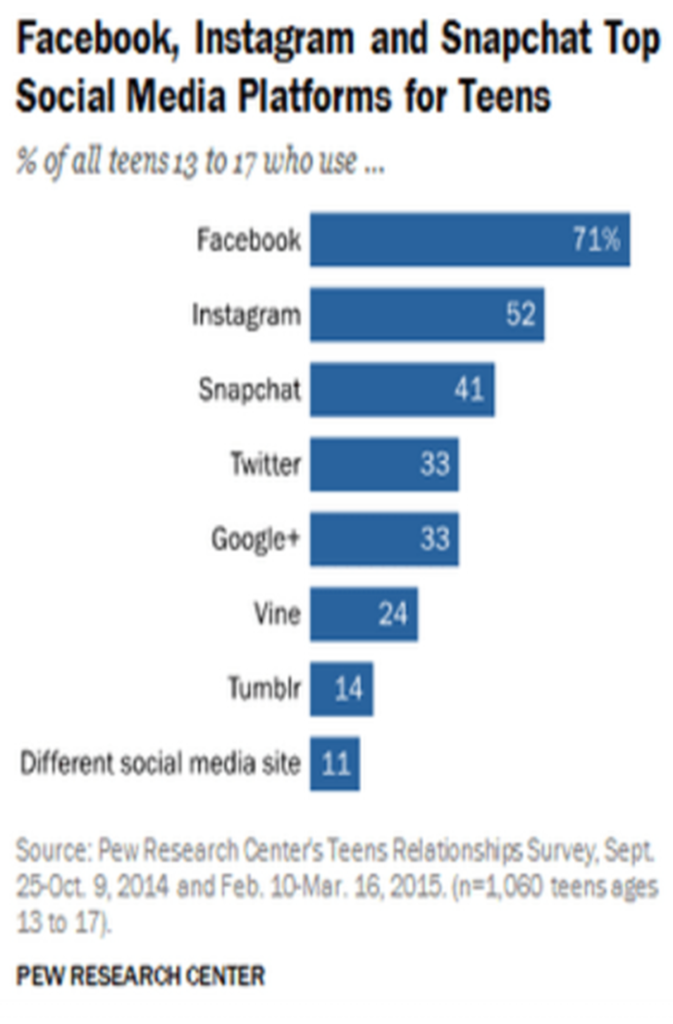
Each social media network has a distinct audience that you should consider when creating visual content. Facebook live videos get ten times more views than regular ones. According to the Pew Research Center, Instagram, YouTube, and Snapchat are teens’ most popular social media sites. Eighty-five percent of American youths use YouTube, while seventy-two percent of teens access Instagram and six-nine percent of Snapchat users.
If you’re looking forward to targeting a young audience, these are the three most fantastic locations to start. That brings us to our next stat.
34. Use Instagram stories to reach out to people
Instagram Stories are used by more than 500 million people every day, and more than 4 million companies utilize Stories advertisements every month. After seeing a brand or product in Stories, 58% of consumers said they were more interested in it. (Instagram Business)
Even though it isn’t a new phenomenon, it is currently more popular than ever. The same can be said about Instagram stories. After seeing a brand or product in a narrative, 58 percent of individuals are more likely to buy it.
Whether a video or a graphic promotes your company, you may distribute your visual material through Snapchat and Instagram stories.

According to HubSpot’s study, the best approach to get someone’s attention is to tell a brief story. 33.1 percent of US Instagram users are between the ages of 25 and 35; thus, young adults are also a terrific group to target with your story!
35. TikTok’s shares are soaring
TikTok is the second most popular app in terms of customer spending, according to statistics from App Annie. TikTok’s revenue in 2020 was expected to be $1 billion.
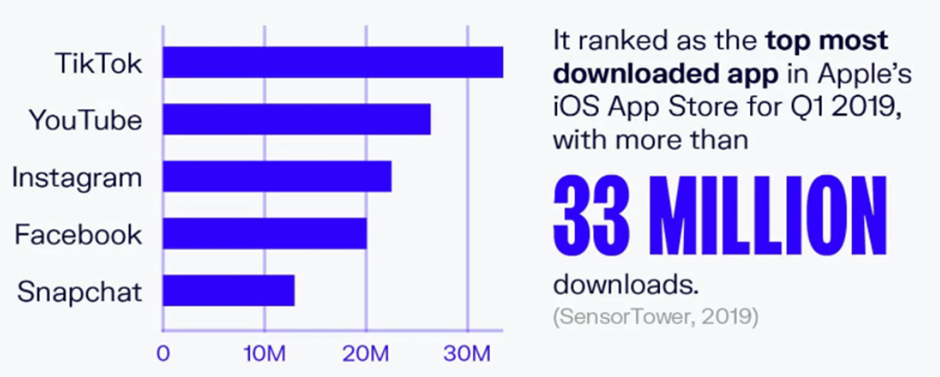
TikTok’s recent market valuation should serve as more proof of the explosive rise of short-form video. After being revived by Vine, video content has been resurrected by TikTok, which has a market value of over $250 billion.
Comedy skits and dance routines are standard features in TikTok videos, typically between 15 and 60 seconds long. TikTok’s popularity has exploded, especially among millennials. You’re missing out if you don’t advertise on the app.
36. Influencer marketing is a huge business
It is predicted that by 2021, the influencer marketing market will have reached historic highs.
Social media platforms are being accessed increasingly often by the general public. The COVID-19 epidemic has only hastened this trend, as individuals under lockdown turn to the internet to pass the time.
As the number of individuals using social media grows, so does the number of people exposed to influencer marketing. As a result, influencer marketing is expected to be worth $13.8 billion by 2021.
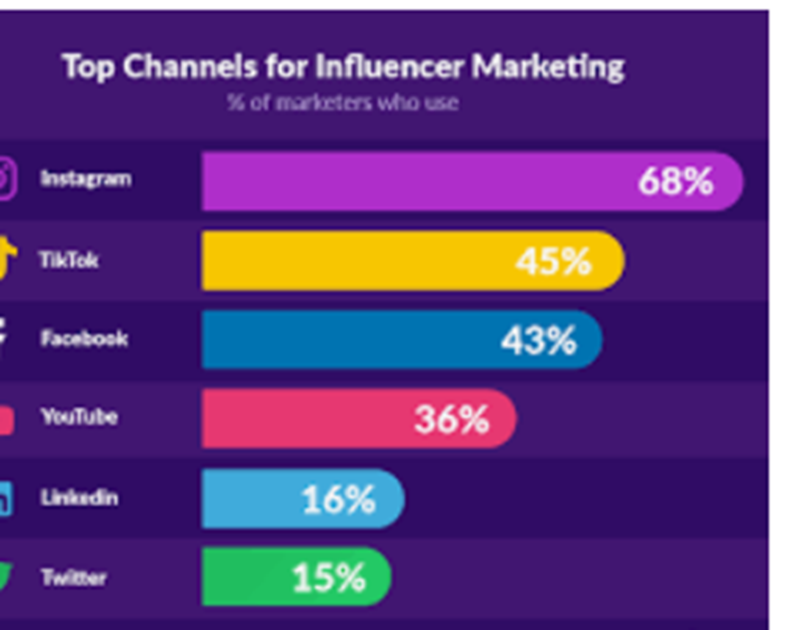
37. Instagram is the best place for influencer campaigns
Influencer culture is a visual spectacle, which is why marketers continue to use Instagram to work with influencers. TikTok, a newcomer to the list, is now the second-most popular medium for influencer marketing. In 2020, TikTok wasn’t even big enough to display on IMH’s graph.
Influencers sell your business with their photographs, allowing you to reach a large audience. In some instances, a single post by an influencer might draw in millions of potential buyers.
38. Pinterest increases sales
More than 600 million people use Pinterest to find visual material every month.

Pinterest is one of the most popular social media platforms for discovering new products to buy. As a result, the platform’s users see incredibly high conversion rates.
Pinterest is a place where people investigate, compare, or admire things they’d like to purchase, so you must promote them, especially if you’re selling clothes, home goods, or other items that are likely to be bought online.
39. Make your Twitter account mobile-friendly
It means that nobody uses Twitter on a desktop or laptop computer. When it comes to your visual content strategy, how should this affect you? Make sure your material is “mobile-friendly,” especially if you’re sharing on Twitter.
Keep your visuals and pictures basic and straightforward. In marketing videos, avoid lengthy shots or too complicated designs. Ensure your link is mobile-friendly if you’re directing people to a third-party site or resource. Make sure to keep in mind that the majority of internet traffic is now coming from mobile devices, so keep that in mind whenever you upload visual information online.
40. Twitter is most popular among those aged 25-49
Twitter, the world’s most popular social media site and the subject of much discussion, is a worthy topic for further investigation. Twitter has a 70% male to 30% female user base. The bulk of Twitter users (28.9%) are aged 25-34, followed by 35-49 (28.2%).
Notably, 20% of Americans use Twitter, totaling roughly 70 million users! If you’re trying to attract a specific audience, using video in your tweets might be the most effective strategy.
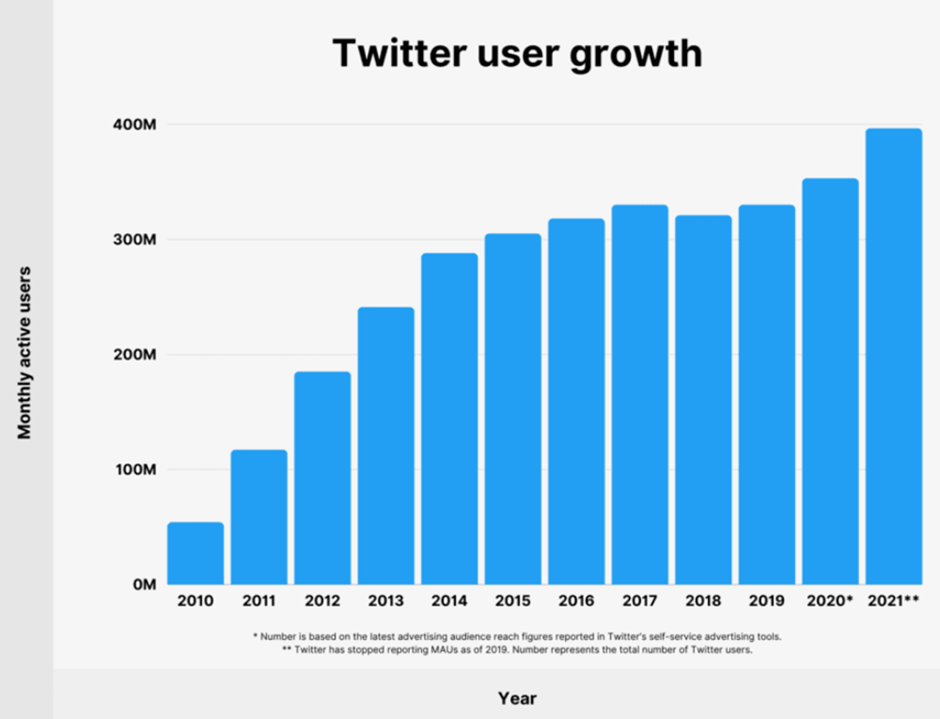
41. LinkedIn users adore visuals
LinkedIn is the most popular social networking site for B2B firms, with 80% of B2B marketers using it. LinkedIn video content has an 82% viewership rate. The majority of LinkedIn users prefer to include a lot of visuals in their posts. If you’re a B2B marketer, you should take advantage of this.
Why? LinkedIn is the number one medium to connect with other brands and generate business. On LinkedIn, the material is frequently seen as more reliable than that found on other sites, such as Facebook, accounting for 46% of all social traffic to B2B websites.
42. Emerging visual marketing trends
A $9.2 billion investment in VR for business is predicted by 2021, exceeding the usage of VR for entertainment. Visual content marketing will continue to see some changes in the following years. You may reap the rewards if you get in on these trends as soon as they emerge. When it comes to virtual and augmented reality, things are about to get much more exciting. Virtual and augmented reality technology will likely be a key marketing channel driven by company investment in the next several years.
More and more companies will invest $9.2 billion in virtual reality (VR) by 2021 due to its increasing use in educating employees, displaying data graphically, and enabling innovative visual marketing.
You may present your products and services to customers in a virtual environment using AR and VR.
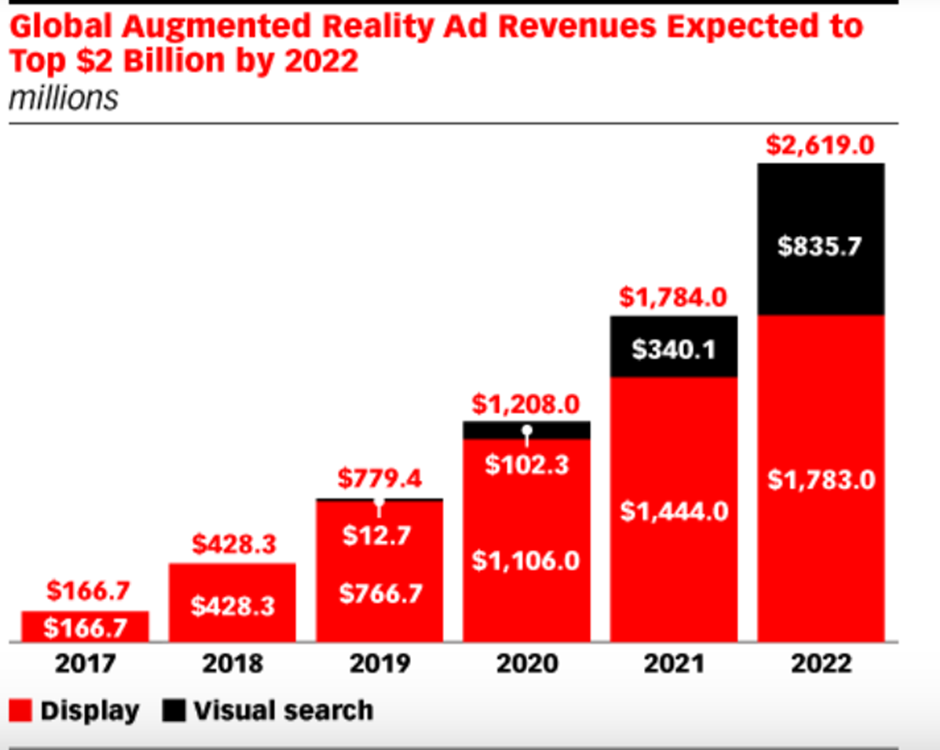
43. VR improves conversions more effectively
Virtual reality will be the next big thing, and it’s already here. Unlike other gadgets, it’s so adept at conversions that it trumps them all. Customers are more likely to respond to your call-to-action when you use VR to promote to them.
Offering virtual reality to your consumers is a one-of-a-kind experience, and that’s why. 53% of individuals say they would select a brand that utilizes VR over a brand that doesn’t use VR if given the option. Sixty-six percent of all consumers would prefer to purchase in virtual reality.
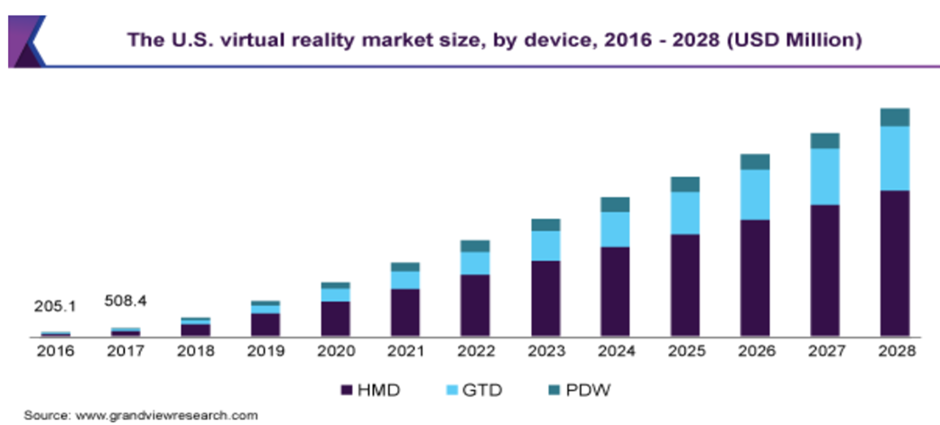
44. Using AR to “Try before you buy.”
If you’re a retailer, you will see a significant impact from AR. Demand for AR-enabled shopping is growing rapidly. Why not take advantage of AR in this context? You may use AR to create a “try before you buy” commercial. An AR ad might allow customers to build their sneakers if they sell footwear.
When you use AR in this way, you’ll increase conversions and the amount of money your customers are willing to spend once they arrive at your site.
45. Enhancing the customer experience through visual search
Another technology that will have a significant influence on retail is visual search.
Shoppers are intrigued about visual search in general and how it might improve their shopping experience. 69% of millennials prefer to conduct their product searches using images rather than text.
Sites like Pinterest are already using visual searches to boost sales. A blog article or advertising should include photographs of the products you’re selling. You’ll improve your customer’s experience while making your content more visible in visual searches. Massive alterations should provide enormous benefits.
46. Become viral or exit
The popularity of memes and social media continues to soar. Therefore, it is more crucial than ever to produce viral visual marketing material. Viral material, such as videos and photographs with millions of views, may be found on apps like Instagram and TikTok.
In this day and age, even a well-placed tweet may become viral. The reason for this is so that your consumers will be more likely to respond positively in the future. There is always the possibility that your graphic material may be a significant hit.
47. Color trends to watch in 2022
There is a current trend for calming color palettes. After the COVID-19 outbreak, it’s clear that people are looking for reassurance in the information they consume. Using color to evoke an emotional response might be the key to a successful design.
48. The popularity of YouTube Shorts is rapidly increasing
The short-video revolution is here—additionally, a new platform for marketing your content via a short video. Although it’s still in its testing phase, YouTube’s TikTok competitor is generating a lot of traction. Keep an eye on this one. Your channel and business might benefit from using YouTube Shorts for marketing purposes. Video content under two minutes long already accounts for almost three-quarters of all online video views.
49. Continue to invest in video
Investing in the video right now is a great idea, and other platforms (like LinkedIn) are doing the same. Pinterest and LinkedIn are attempting to cultivate an influencer culture like Instagram, TikTok, or Snapchat, much like they have done on other social media sites. Video is the most effective method to accomplish this, and Pinterest has already seen notable benefits in this area. On-trend for 2022 and beyond, video is here to stay, and its effectiveness is shown by this visual.
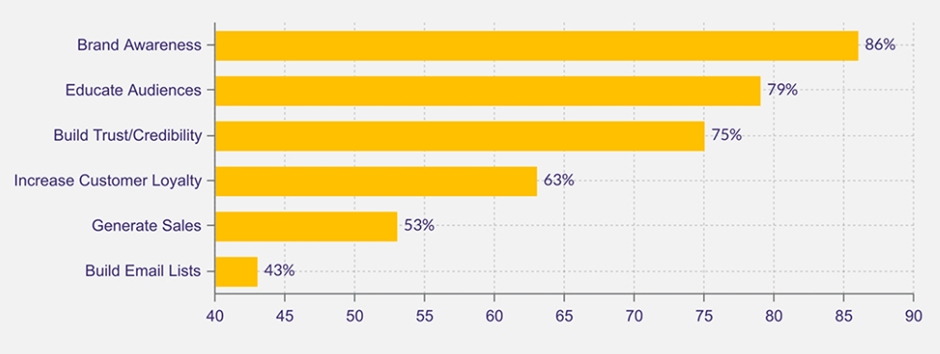
50. Live video continues to grow in popularity
As the popularity of social media continues to rise, marketers will use these channels to increase the number of people who see their advertising. Using Facebook Live and Instagram Live in 2022, marketers will be able to take advantage of live video’s ability to drive high levels of engagement.
Key Takeaways
- Always be active: Visual material, whether it’s infographics, photographs, or videos, directly impacts your audience’s engagement, and you should keep this in mind at all times.
- This video is exceptionally well made: A video is an excellent tool for attracting attention and promoting sales. Video is already huge, but new technology like virtual reality (VR) and new platforms like TikTok and YouTube Shorts are poised to make it much bigger.
- Instagram is (most likely) the best social media platform: Instagram may be the most acceptable all-around channel to reach your clients right now, even though YouTube and Facebook are still prominent.
- Making a significant effort pays off: Take your time, and don’t rush. Attract top-notch employees. Take care of your finances wisely. When it comes to visual content marketing, “you harvest what you sow,” as the saying goes, and that’s more true than ever.
- Digital is better than print: When it comes to business and trade, you can’t afford to be left behind; remain up-to-date with what’s going on in the digital world.

Conclusion
There are several facets to visual content marketing. So many varieties, so many trends, and so many outlets to choose from when promoting your content. In the end, it’s a success. Visual material has proven the most successful when it comes to increasing your marketing performance across all metrics. And the visual content marketing stats mentioned above showcase that.
If you haven’t done so before, you should create more graphic material. You should also invest more if you’re only putting in a modest quantity of money. In the future, visual material will be the most acceptable method to sell your business, and the rewards of a good campaign will be enormous.
FAQs
Forty-nine percent of marketers say visual marketing is critical, while 22% say it is vital. Forty-nine percent of marketers employ graphic material on their websites and blogs, followed by social media. People remember 65% of what they see three days later than 10 percent of what they hear.
The human brain processes visual material 60,000 times quicker than text. Even if a picture and a block of text express the same core notion, this is still valid for understanding. 90% of the information sent to the human brain in a day is visual.
Thirty-six thousand visual signals can be processed every hour by the eyes. In less than a tenth of a second, a viewer can get a sense of a visual scene. Visual information makes up 90% of the data sent to the brain. Visuals are processed 60,000 times quicker than text in the brain.
The number of followers, likes, shares, visits, customers, and income generated by marketers that use visual content is higher. Visual material is becoming increasingly vital in today’s marketing strategy, whether it’s social media or email marketing.
Visually rich material, such as blog posts and social media posts, is more likely to be shared and viewed by customers. For example, tweets containing photos get up to five times as much attention as those without. Ninety-four percent more people see articles with images.
The visual nature of our environment has been steadily increasing throughout time. With over 3 billion photos posted every day, internet businesses are scrambling to provide visually appealing content that will appeal to a broader audience.
Decide on a specific topic. It’s preferable to keep your image focused on a single subject.
Make use of the sun’s rays to your advantage.
The contrast should be at least two shades of grey
Complementary hues are best
Keep things simple
If you edit too much, you’ll end up with a sloppy product
Latest Blogs
Explore how Google’s 2025 AI search updates triggered ranking chaos. Learn actionable strategies to adapt your SEO for AI Overviews, zero-click searches, and SERP volatility. Stay ahead now.
Learn how to rank on AI search engines like ChatGPT, Perplexity, and Gemini by optimizing your content for authority, structure, and relevance. Stay ahead in AI-driven search with this strategic guide.
Explore the best healthcare SEO services for your medical practice. Improve online visibility and effectively reach more patients in need of your services.
Get your hands on the latest news!
Similar Posts

Content Marketing
4 mins read
11 Best B2B Content Marketing Agencies for B2B Companies in 2024

Content Marketing
5 mins read
Top ecommerce Marketing Agencies with Proven Strategies for 2024

Content Marketing
5 mins read